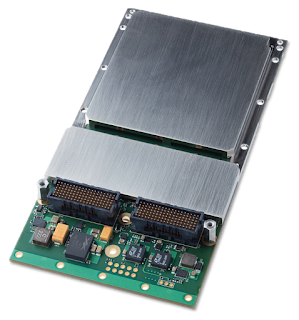Press Release
Tualatin, OR – June 28, 2016
VersaLogic Corp., the embedded industry's most trusted computer company, has announced Osprey - an extremely small, rugged, embedded computer.
This next generation of the VersaLogic Embedded Processing Unit (EPU) format combines processor, memory, video, and system I/O into an extremely compact full function embedded computer. The computer has a footprint just slightly larger than a credit card.
View datasheet
 The
Osprey was engineered to meet the military, avionic, and medical
industries' evolving requirements for smaller, lighter, and more
powerful embedded systems. Roughly the size of a credit card and less
than 1.1 inches (28mm) thick, the Osprey is a highly-integrated embedded
computer. It combines the new 4th generation Intel® Atom™ "Bay Trail"
processor, with newer system interfaces, in a form factor designed to
withstand extreme temperature, impact, and vibration.
The
Osprey was engineered to meet the military, avionic, and medical
industries' evolving requirements for smaller, lighter, and more
powerful embedded systems. Roughly the size of a credit card and less
than 1.1 inches (28mm) thick, the Osprey is a highly-integrated embedded
computer. It combines the new 4th generation Intel® Atom™ "Bay Trail"
processor, with newer system interfaces, in a form factor designed to
withstand extreme temperature, impact, and vibration.Osprey is available in single, dual, and quad core models. The single core is suitable for lower-cost, lower power systems, while the quad core is ideal for UAV video applications where both higher performance and small size are important.
"We are excited to offer another EPU model with increased I/O capabilities. Adding USB 3.0, an additional half-sized mini PCIe socket, a second Ethernet port, digital I/O, and an I2C port allow our customers to support their I/O needs in one small package," said Gary Harris, VersaLogic's Director of Technology.
The Osprey features an industrial temperature Intel Atom E38xx processor optimized for performance and power balance. Osprey provides compatibility with a broad range of x86 operating systems and application development tools for reduced cost and development time.
Powerful Video Processing
Intel's advanced Gen 7 HD graphics engine provides outstanding graphics performance and is capable of supporting two simultaneous 1080p video streams. On-board hardware acceleration is available for encode/decode of H.264, MVC, VP8, VC1/WMV9, and other standards. The graphics engine also supports DirectX 11, Open GL 4.0, full HD video playback, dual display support, and resolution up to 2560 x 1600 @ 60Hz. Osprey supports a Mini DisplayPort++ output as well as a single-channel LVDS display output.High Performance I/O Capabilities
Osprey's I/O connectivity includes dual Gigabit Ethernet ports with network boot capability, one USB 3.0 and four USB 2.0 ports, I2C, eight digital I/O's, and two serial ports. A SATA 3 Gbits/s interface supports high-capacity rotating or solid-state drives. Full and half-sized Mini PCIe sockets, a microSD socket, and on-board eMMC (on some models) provide flexible solid-state drive (SSD) options. Systems can be enhanced by leveraging the Mini PCIe sockets with plug-in Wi-Fi modems, GPS receivers, MIL-STD-1553, Ethernet, Firewire, and other mini PCIe cards/modules.Designed, Manufactured and Tested for Extreme Environments
Designed and tested for industrial temperature (-40° to +85°C) operation, the Osprey also meets MIL-STD-202G specs for impact and vibration.Osprey's on-board power filtering adds an important layer of protection for glitches caused by dirty or unstable power sources. The wide input voltage range (8 to 17 volts) greatly simplifies system power supply requirements. It is fully compatible with automotive type (nominal 12V) power systems. Soldered-on RAM and fanless thermal solutions provide additional ruggedisation for use in harsh environments.
Long-term Availability
The Osprey is covered by VersaLogic's 5-year product warranty and 5+ year availability guarantee. VersaLogic's Life Extension programs typically keep products available for 10+ years. Customisation services to help customers create unique solutions are available for the Osprey, even in low OEM quantities. Customisation options include conformal coating, revision locks, custom labeling, customized testing and screening, and more.Pricing and Availability
The Osprey (part number VL-EPU-3311) is now in stock. OEM quantity pricing starts at $709 for the single-core model with 2 GB RAM.For more information please contact Sarsen Technology - info@sarsen.net


